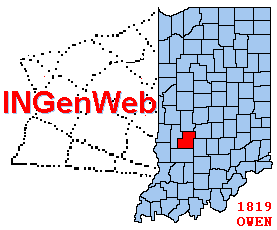Gosport
 Gosport is a town on the eastern edge of Owen County, on the banks of the White River.
Gosport is a town on the eastern edge of Owen County, on the banks of the White River.
Named for Ephraim Goss, the town was platted in 1829. A post office has been in operation at Gosport since 1843, and major industries included pork curing, packing, and shipping. Goss and Abner Alexander surveyed and platted 36 acres of land sloping towards the river.
The original plat included 16 blocks and 112 lots, with Adams, Market, and Jackson Streets (later changed to numbered streets) running in a north-south direction and North, Main, and South Streets in an east-west direction. The town was bounded on the east by White River, with a bluff donated by the founders for use by the public. The town site was located on this bluff and the high ground to the west and north, bringing it well above the flood plain. The Gosport Historic District is contained within the original plat.
Geology
The land on which Gosport is situated, along with most of Owen County, is graced with dramatic topography, the result of underlying old limestone strata which was uplifted in geologic time and slowly eroded to its present conformation. Across White River on the south is Monroe County, and south of it is Lawrence County: the two counties are home to the state's famed Oolitic limestone quarries, which provided much of the nation's supply of fine-grained building stone. Oolitic limestone, used for architectural details on Gosport commercial buildings, was available at the Hoadley family quarry across White River at Stinesville in Monroe County, just a few miles from Gosport. Nearby beds of Keokuk limestone provided very durable stone for Gosport foundation walls, cellar walls, and other rough rubble masonry. In addition, St. Louis limestone was quarried at Spencer, a distance of 10 miles. Known as "Spencer stone," it also appears in foundations throughout Gosport. The poorer quality Kaskaskia limestone was used primarily for road material in Owen County. Chester sandstone, which was durable for buildings, was also quarried in the county, along with other extractable materials.
Industry
Gosport's earliest industries were based on the abundant natural resources in the area. The rich alluvial bottom lands of White River were highly productive for agriculture. The river also provided water power for flour and saw mills before the active use of steam-powered engines. Timber was harvested in large quantities, and both building and finish lumber such as that produced at the J. L. Rumbarger mill, were popular products. Underlain with limestone, the rolling blue grass hills of Wayne Township were perfect for raising cattle, horses, and pigs. The latter were instrumental in Gosport's early financial success. Other natural resources in the township included some coal (in the southwest) and vast amounts of clays for brick, pottery, and tile manufacturing. In 1884, a positive future for the growth of fruit trees was predicted, and pure spring waters were said to be found in almost every quarter section. Wells within the town of Gosport, such as that found on the Dr. Howard and Hattie Osgood property, were renowned for their cool, sweet water.
Due to its river access, Gosport became a prominent regional livestock market in its early years. Salt and sugar curing of pork and its packing and shipping was the primary industry from about 1830-1855. Perhaps because the industry was concentrated in the hands of only a few individuals, the town was slow to grow until after 1853, when the Louisville, New Albany, and Chicago railroad (later the Monon line) was completed through the village. Incorporated in 1865, Gosport was the first town in the county to host passenger and freight travel, and it quickly became a prime trade town in the area. A second railroad, the Indianapolis and Vincennes, was completed in 1869. Gosport Junction, a crossing of the two railroad lines just northeast of the town, became an important commercial and industrial hub. The railroads quickly surpassed river traffic because they were more reliable, faster, and could operate during all seasons of the year. From 1869 to the early 1920s, 12 daily passenger trains passed through Gosport on the two lines. By the mid-1890s, a large industrial district soon developed near the railroads east of downtown and along White River. By 1890, there was a flour mill, saw mill, bell factory, and hub and spoke factory. There were also seven hotels to serve travelers and salesman who were required to stay overnight.
Another important transportation system was the network of roads linking communities both near and far. As roads improved and traffic increased, river crossings were upgraded from ferries to bridges. In 1871, a covered bridge built over White River between Gosport and Mt. Tabor in Monroe County made the crossing easier, although a ferry continued to operate. In 1895, it was joined by a new iron truss bridge. Though the railroads and roads drained people and business activity to the Owen County seat of Spencer, Gosport continued to prosper.
20th Century
By the 1920s, however, Gosport's fortune began a downturn. Construction of the new State Road 67 bypassing Gosport began in 1929 and was completed in 1936. Although road construction provided jobs during the first year of the Depression, the increasing popularity of the automobile made it easy for residents to do business elsewhere and for visitors to slip by. And though passenger trains continued to run through Gosport into the 1950s, they no longer stopped after 1945. By the time the covered bridge was burned by vandals in 1955, White River was a barrier to the town rather than a lifeline.
The commercial core of Gosport as it appears today began to develop in the mid-1830s. The earliest buildings were frame construction and include the east part of the Gosport Tavern, built in 1835. The town's peak commercial growth occurred between 1850 and 1930, a period marked by the building and rebuilding of its commercial core due to fires on July 18, 1891; January 20, 1909, and November 30, 1919. Subsequent fires on January 24, 1946, and January 7, 1970, also led to rebuilding. but the motivation was less confidence in a prospering town than an attempt to invigorate and sustain the community against a slow decline that had begun in the 1920s and 1930s.
Consolidation of Owen County schools in 1966 led to the closure of Gosport High School, a center of community life. The elementary classes were spared, however, and a new Gosport Elementary School was built in 1971. The 1970s brought other changes - both significant and symbolic - with the demolition of the Monon railroad station in 1976 and the closing of longtime businesses, including Moore's Variety Store after 57 years. Yet the decade inspired optimism as well. The 1970 fire that destroyed nearly a quarter of a block at the southeast corner of Main and Third Streets launched a creative redevelopment strategy. A small group of residents established the Gosport Development Corporation and sold shares to finance the construction of a grocery store to serve the community.
In the early 1990s, community leader John King, new property owner John McFarlane, the Gosport Business Association, and the Gosport Development Corporation plotted a revitalization strategy that resulted in the partial restoration of the Knights of Pythias Lodge/Opera House and facade facelifts on several buildings. In the late 2000s, the availability of Community Focus Fund grants through the Indiana Office of Rural and Community Affairs, made further revitalization possible. The Gosport Revitalization Plan was prepared by RATIO Architects, Inc., in 2008-2009. In 2010-2011, grants and other funding led to installation of the town's first storm water system, new downtown streets, sidewalks, and street furniture. In regards to infrastructure, Gosport has had electricity since 1898 or 1899; a privately owned light plant was built in 1897, but it was another year or more before town officials accepted service and agreed to pay for it. By 1929, it was a holding of Wabash Valley Electric Company. A town water system was completed in 1926, three years after citizens petitioned for one to the town board. In 1909, the town boasted 'miles of cement walks. In 1924, concrete sidewalks and curbs in the commercial area were installed, according to several deeds that noted assessments that were due.
By 1931, a writer for the local paper boasted that Gosport had a "city water system, concrete sidewalks, curbs, and ditches, and macadam streets." There are a number of transportation-related resources in the Gosport Historic District that reflect the transition from the horse and buggy to automobile as a means of travel. The Benjamin F. Hart Livery Stable and the carriage barn behind the Dr. H. G. and Hattie Osgood House are excellent representations of the former. Hart was a commercial liveryman, renting horses, wagon, and buggies for others to use. His business also boarded horses for ovemight visitors and travelers. The livery barn has horse stalls on either side of a center aisle and a hay loft overhead. Dr. Osgood's carriage bam reflects his upper-middle class lifestyle and his profession. His practice as a physician required him to travel throughout and minister to patients in several counties.
A third resource associated with horse and buggy travel is the carriage stone on the south lawn of the Grimsley-Runyan-Brown-Owens House. As the horse and buggy gave way to the automobile, garages began to appear in rear yards. At first they were just large enough to accommodate a family's sole automobile. Some garages, such as the wood frame building at the Tom and Hattie Dodd House, appear to have been rather quickly built and reflect a status clearly secondary to the house. Other garages, such as the 1950 glazed tile block model at the Fox-Hart-Hoadley House, reflect the garage's increasing importance within the domestic sphere. By the last quarter of the twentieth century, the attached garage has literally become a part of the house itself. The Brown-Brighton House at the corner of Fourth and Walnut Street is a good example. The original 1911, single bay garage on the north-south alley has been replaced by a large two-bay attached garage at the house's southeast corner. Another observation of note is how the Gosport Historic District has been impacted by a pattern of clustering family members in close proximity to each other. This is particularly evident at the district's southern boundary, where several interrelated families built houses. Three children of Thomas and Sarah (Robinson) Criss, who lived at 126 E. South St., built their own houses near that of their parents. Three of Sarah's sisters also lived nearby in houses of their own. After sister Eliza Grimsley's death, her house at 126 S. Fourth St. was sold to Evander and Jesse Runyan, who had the house next door at 130 S. Fourth St. built for their daughter and her family. It is this clustering that redefined and expanded the southern boundary of the Gosport Historic District.
Source: Gosport Historic District National Register of Historic Places Registration Form



